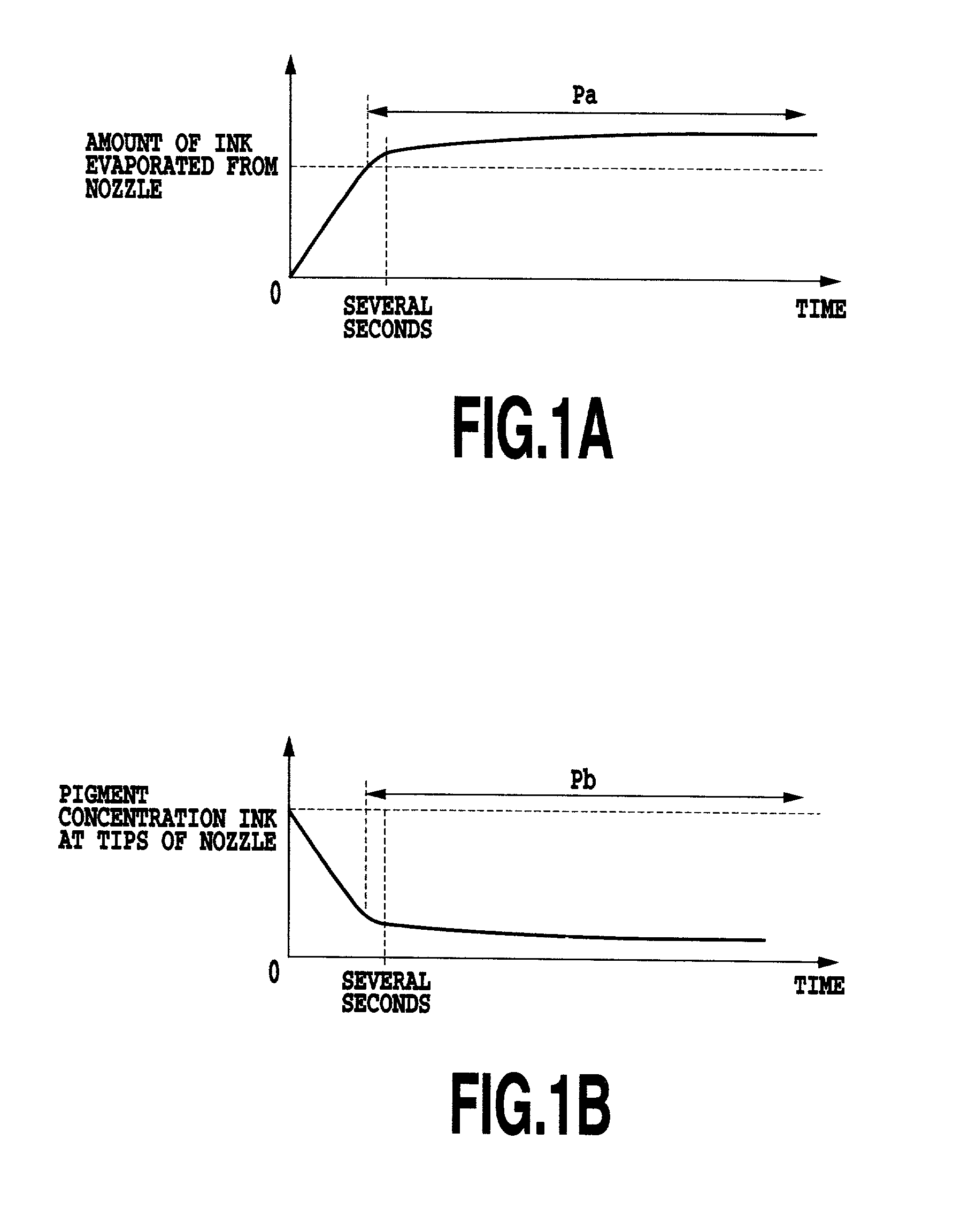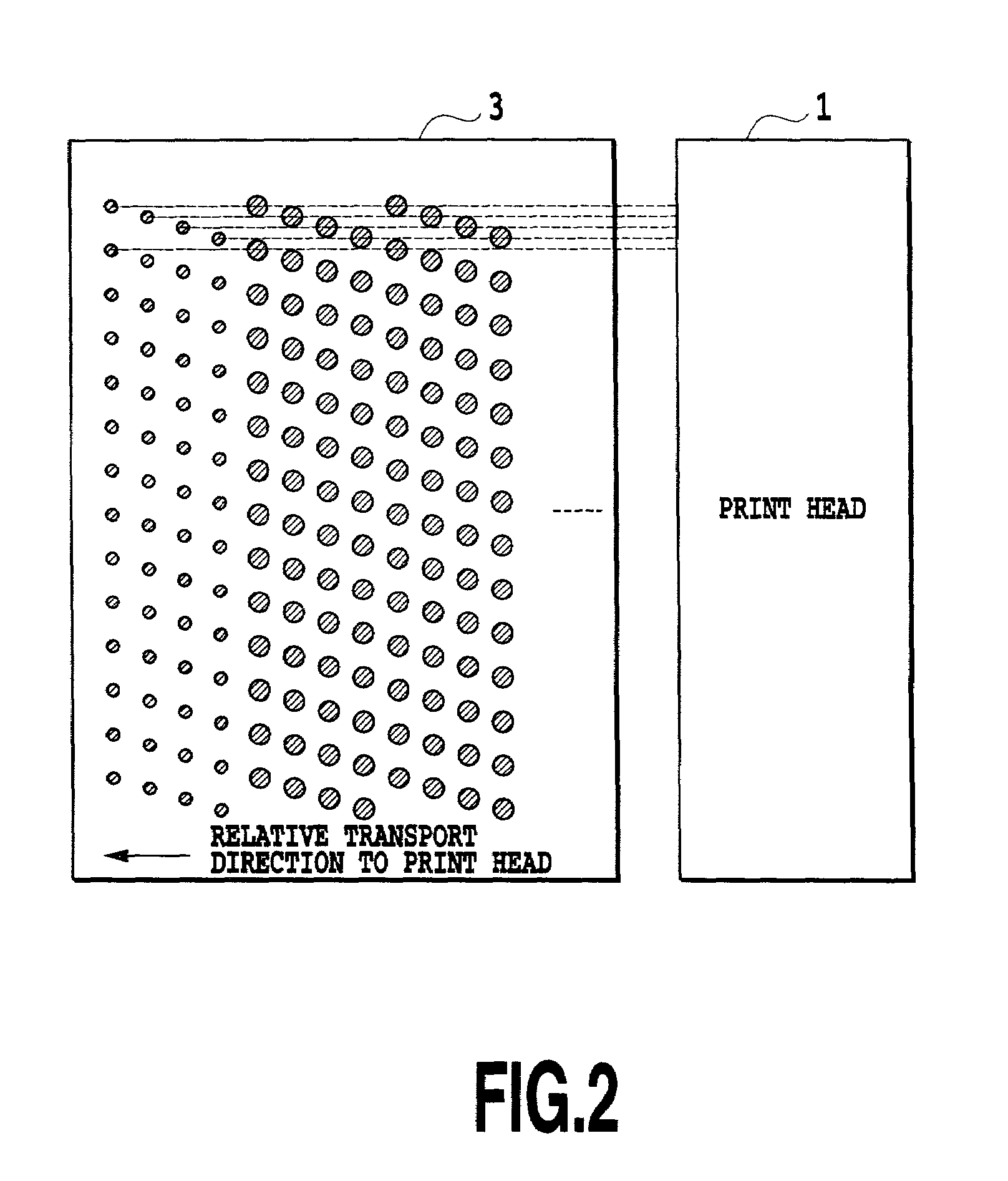[0014]The inventors have noted that the amount of ink passing through a
nozzle or the concentration thereof may decrease at the first ejection or the first and subsequent several ejections following the last one though only time much shorter than the interval for conventional ejecting operation has passed since the last ejection.
[0017]On the other hand, it has been confirmed that the
optical density of dots formed by ink ejected may decrease (second phenomenon) in the case that a
pigment is used as a color material of ink. That is, in the case of using ink containing the
pigment as the color material, the
pigment concentration of ink ejected may decrease at the first ejection or the first several ejections executed after a certain time has elapsed since the last ejection. As a result, the
optical density of dots formed by the ink ejected is reduced. It has also been confirmed that the concentration of the ink recovers to a normal value after the first ejection or the first and subsequent several ejections. Further, it has been ascertained that as in the case with the first phenomenon, such a decrease in the
optical density occurs after the last ejection from the
nozzle and within time much shorter than the interval for the conventional ejecting operation. This second phenomenon degrades the image on the print medium as in the case with a decrease in the amount of ink ejected resulting from the formation of the film.
[0018]The formation of the film associated with the first phenomenon has long been known. Thus, attempts have been made to use ink having such a composition as prevents a thin film due to the increased viscosity of the ink from being formed on the surface of ink in the vicinity of the nozzle within a short time (order of several seconds). However, the limitation of the ink to such a composition that prevents the film from being formed during a short time may reduce the degree of freedom of an apparatus design for improving the printing grade. For example, in the case that the film is unlikely to be formed on the surface of ink under
atmosphere in the vicinity of the nozzles, it is difficult to restrain the
evaporation of
moisture (ink
solvent). Thus, with large ejection intervals, the ink viscosity increases to cause a thicker film to be formed, thereby making it difficult to recover normal ejection or increasing the concentration of ink above the normal value at the first ejection. Eventually, this leads to the use of ink having such a composition that the thin film is formed during a short time (several seconds).
[0022]Further, another aspect of the present invention relates to an ink jet printing apparatus that can execute printing with ink containing a pigment as a color material. The ink jet printing apparatus comprises a print head having a nozzle and can perform a preliminary ejecting operation that does not contribute to printing. An optical density obtained from a pigment concentration of ink ejected through the nozzle in the print head may vary depending on the time during which no printing process is executed. In view of this point, in this ink jet printing apparatus, the preliminary ejecting operation is performed taking an opportunity in which the optical density obtained from the pigment concentration of ink passing through the nozzle is decreased below a normal value.
[0027]According to the present invention, the preliminary ejecting operation is performed taking an opportunity to reduce the amount of ink ejected, thereby reducing the amount of ink ejected during the preliminary ejecting operation below the normal value. Further, the preliminary ejecting operation is performed taking an opportunity to reduce the optical density, thereby reducing the optical density obtained from the ink ejected during the preliminary ejecting below the normal value. Consequently, if the preliminary ejecting operation is performed on a print medium, dots formed on the print medium by this operation will not be so conspicuous. Further, the opportunity to reduce the amount of ink ejected or the optical density generally corresponds to a small number of ejections executed after a certain time has elapsed since the last ejection. Typically, the preliminary ejecting operation corresponds to the first ejection or the first several ejections following the last one. Therefore, the amount of ink ejected during the preliminary ejecting operation can be reduced.
 Login to View More
Login to View More  Login to View More
Login to View More 


